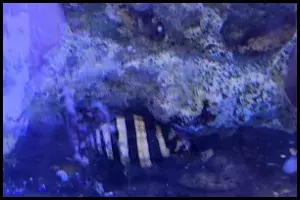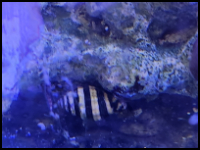
Quick Care Details (Table)
| Livestock Characteristics | Value |
|---|---|
| Care Level | Easy |
| Temperament | Peaceful |
| Diet | Carnivore |
| Maximum Size | 1-2 Centimeters |
| Minimum Tank Size | 10 Gallons |
| Reef Safe | Yes |
| Temperature Range | 72-78°F (22-26°C) |
| PH Range | 8.0-8.4 |
| KH Range | 6-10 dKH |
| GH Range | 8-12 dGH |
Species Specific Categories
Helpful Video
Care Details
- Aquascape: Bumble Bee Snails prefer aquarium setups with plenty of hiding spots and crevices to explore. Incorporating live rock or artificial structures can provide them with suitable hiding places.
- Substrate: A sandy substrate is ideal for Bumble Bee Snails, as it mimics their natural habitat. Avoid using sharp or coarse substrates that could damage their delicate bodies.
- Disease Prevention: Maintaining good water quality and proper tank hygiene is essential for preventing diseases in Bumble Bee Snails. Regular water changes, proper filtration, and quarantine procedures for new additions can help minimize the risk of disease outbreaks.
- Filtration: A reliable filtration system is crucial for keeping the aquarium water clean and free of debris. Choose a filtration system that provides mechanical, biological, and chemical filtration to ensure optimal water quality.
- Lighting: Bumble Bee Snails do not have specific lighting requirements and can thrive under standard aquarium lighting. However, providing a consistent lighting schedule can help regulate their behavior and maintain a stable environment.
- Water Flow: Moderate water flow is recommended for Bumble Bee Snails, as they prefer areas with gentle to moderate water movement. Ensure that the water flow in the aquarium is not too strong, as it may stress or dislodge the snails.
- Hardiness: Bumble Bee Snails are generally hardy and can adapt well to aquarium conditions when provided with suitable habitat and water parameters.
- Acclimation: When introducing Bumble Bee Snails to a new aquarium, it's important to acclimate them slowly to prevent stress and shock. Gradually adjust the water parameters over a period of time using the drip acclimation method before releasing them into the tank.
- Expected Lifespan: Bumble Bee Snails have an average lifespan of 1-2 years in captivity, although with proper care, they may live longer.
- Special Requirements: Bumble Bee Snails do not have any specific special requirements beyond the typical care considerations for marine invertebrates. However, providing a varied diet and maintaining stable water parameters are essential for their health and longevity in the aquarium.
Temperament and Behavior
- Behavior: Bumble Bee Snails exhibit calm and peaceful behavior in freshwater aquariums. They are primarily nocturnal and spend their days hiding in crevices or under substrate, emerging at night to forage for food.
- Breeding: Breeding Bumble Bee Snails in freshwater aquariums is rare and challenging. It typically requires specific conditions mimicking their natural habitat, including suitable hiding spots and stable water parameters. Successful breeding attempts may result in the deposition of small, transparent eggs in the aquarium.
- Aggression: Bumble Bee Snails are non-aggressive and generally pose no threat to other tank inhabitants. They peacefully coexist with a variety of freshwater fish, shrimp, and other peaceful invertebrates.
- Tankmates Compatibility: Bumble Bee Snails are compatible with a wide range of freshwater tankmates, including small and peaceful fish species, such as tetras, rasboras, and dwarf cichlids. They also cohabitate well with freshwater shrimp, snails, and other invertebrates.
- Activity Level: Bumble Bee Snails are primarily nocturnal and exhibit low to moderate activity levels during the night when they emerge to graze on algae and detritus. During the day, they prefer to remain hidden in sheltered areas within the aquarium.
- Schooling or Shoaling Behavior: Bumble Bee Snails do not exhibit schooling or shoaling behavior. They are solitary creatures and typically prefer to forage and explore the aquarium individually.
- Plant Compatibility: Bumble Bee Snails are generally compatible with live freshwater plants. They do not pose a threat to most aquatic plants and may even help control algae growth on plant surfaces. However, precautions should be taken with delicate or easily uprooted plants, as the snails may inadvertently disturb them while foraging.
Diet and Nutrition
- Dry Foods: Bumble Bee Snails may consume some dry foods like algae wafers or sinking pellets designed for bottom-dwelling fish. However, they primarily feed on live algae and detritus.
- Frozen Foods: While Bumble Bee Snails may occasionally consume small particles of frozen foods, they do not rely heavily on frozen foods as a significant part of their diet.
- Live Foods: Bumble Bee Snails thrive on live foods, particularly algae and biofilm found naturally in the aquarium. They actively graze on algae growth on surfaces within the tank.
- Vegetables: Bumble Bee Snails may consume certain types of blanched vegetables, such as zucchini or cucumber slices. These vegetables can provide additional nutrients and fiber to their diet.
- Algae: Algae is a staple part of the Bumble Bee Snail's diet. They graze on algae growth on various surfaces within the aquarium, helping to control algae levels and maintain a clean environment.
- Feeding Schedule: Bumble Bee Snails are opportunistic feeders and will continuously graze on algae and detritus as it becomes available in the aquarium. Providing a consistent source of live algae and occasional supplemental foods is sufficient for their nutritional needs.
- Supplemental Foods: While live algae is their preferred food source, Bumble Bee Snails may benefit from occasional supplemental foods such as algae wafers, sinking pellets, or blanched vegetables. These foods can provide additional nutrients and variety to their diet, although they should be offered in moderation.
Tank Parameters
- Tank size: Bumble Bee Snails can thrive in a variety of tank sizes, ranging from small nano tanks to larger aquarium setups. A minimum tank size of 10 gallons is recommended to provide sufficient space and stability for these snails.
- Tank Length and Measurements: Bumble Bee Snails are not particularly sensitive to tank length and measurements as long as the tank provides ample space for them to explore and graze. However, longer tanks may offer more horizontal swimming space and accommodate a greater variety of tankmates.
- Water Temperature: Bumble Bee Snails prefer freshwater aquariums with stable water temperatures ranging from 72-78°F (22-26°C). It's essential to use a reliable aquarium heater to maintain consistent water temperature within this range.
- pH (Acidity/Alkalinity): Bumble Bee Snails tolerate a wide range of pH levels in freshwater aquariums, typically between 7.0-8.0. However, they prefer slightly alkaline conditions, with a pH level around 7.5-8.0 being ideal for their health and well-being.
- KH (Carbonate Hardness): Bumble Bee Snails can adapt to varying carbonate hardness levels in freshwater aquariums. Aim for a KH level between 6-10 dKH to provide adequate buffering capacity and stability for the aquarium environment.
- GH (General Hardness): Bumble Bee Snails are adaptable to different general hardness levels in freshwater aquariums. A GH level between 8-12 dGH is suitable for their health and vitality, although they can tolerate slightly softer or harder water conditions.
- Hardiness: Bumble Bee Snails are generally hardy and can adapt well to a wide range of freshwater tank parameters, including temperature, pH, and water hardness. However, sudden fluctuations in water parameters should be avoided to prevent stress and potential health issues.
- Nitrate (NO3) levels: Bumble Bee Snails are sensitive to high nitrate levels in freshwater aquariums, which can indicate poor water quality. Aim to keep nitrate levels below 20-40 ppm through regular water changes and proper aquarium maintenance to ensure the health and well-being of the snails and other tank inhabitants.
History, Popularity, History and Species Variety Details
The History, Popularity and Natural Habitat:
History: The Bumble Bee Snail, scientifically known as Engina mendicaria, doesn't have a well-documented history in the aquarium trade due to its relatively recent introduction to hobbyist circles. It's a species that's garnered interest among aquarium enthusiasts in recent years, primarily for its striking coloration and potential benefits in controlling algae growth within aquariums.
Popularity: While not as widely known or sought after as some other aquarium species, the Bumble Bee Snail has gained popularity among hobbyists who appreciate its unique appearance and beneficial algae-eating behavior. Its popularity has been on the rise as more aquarium enthusiasts become aware of its presence and potential contributions to maintaining a healthy aquatic environment.
Natural Habitat: In its natural habitat, the Bumble Bee Snail is found in the Indo-Pacific region, inhabiting shallow waters ranging from intertidal zones to depths of around 100 feet. It's commonly found on rocky substrates, coral reefs, and in sandy areas with plenty of hiding spots. These snails prefer areas with moderate water flow and ample algae growth, as they primarily feed on algae and detritus found in their surroundings.
Back to topSimilar and Variations of the Species:
-
Nassarius Snail (Nassarius spp.): Nassarius snails share similar characteristics with Bumble Bee Snails, including their scavenging behavior and preference for sandy substrates. However, Nassarius snails have a more rounded shell and are typically larger in size compared to Bumble Bee Snails.
-
Cerith Snail (Cerithium spp.): Cerith snails are another species commonly kept in aquariums for their algae-eating habits and ability to burrow into sand substrate. They have elongated, spiral-shaped shells and are known for their efficiency in consuming detritus and algae in aquariums.
-
Nerite Snail (Neritina spp.): Nerite snails are popular algae-eating snails known for their vibrant coloration and unique shell patterns. They are similar to Bumble Bee Snails in their algae-eating behavior but have different shell shapes and patterns, making them a visually appealing addition to freshwater and saltwater aquariums alike.
Personal Perspective
As an aquarium enthusiast, keeping Bumble Bee Snails has been an absolute delight for me. I vividly remember the day I added them to my aquarium, carefully acclimating them to their new environment before gently releasing them into the tank. Their distinctive black and yellow banded shells immediately caught my eye, adding a vibrant pop of color to the aquascape.
Watching these snails explore their new home was fascinating. They quickly found their favorite hiding spots among the rocks and crevices, occasionally peeking out to graze on algae and detritus covering the surfaces. Their nocturnal behavior added an extra layer of intrigue to my aquarium, as I often found myself observing them during their nighttime foraging expeditions.
One of my most rewarding experiences with Bumble Bee Snails is witnessing their impact on algae control within my aquarium. Over time, thanks to the diligent efforts of these little snails, I noticed a significant reduction in algae growth. Not only did they contribute to the overall cleanliness of the tank, but they also added a natural and sustainable method of algae management without the need for chemical interventions.
Beyond their practical benefits, the Bumble Bee Snails have also become a charming addition to my aquarium community. Their peaceful demeanor and unassuming presence make them wonderful tank mates for a variety of fish and invertebrates. I've even caught glimpses of them interacting with other inhabitants, peacefully coexisting as they go about their daily routines.
Overall, keeping Bumble Bee Snails has been a rewarding experience filled with moments of fascination and appreciation for these unique creatures. They've added visual interest and practical benefits to my aquarium, enriching the underwater ecosystem and bringing me joy as I continue caring for them in my aquatic haven.
Frequently Asked Questions
Can Bumble Bee Snails be kept in a community tank?
Yes, Bumble Bee Snails are peaceful creatures and can coexist with a variety of freshwater fish, shrimp, and other invertebrates in a community tank setup.
Do Bumble Bee Snails reproduce quickly and overcrowd the tank?
No, Bumble Bee Snails reproduce at a relatively slow rate compared to some other aquarium snail species. They rarely overpopulate and are unlikely to become a nuisance in the tank.
How do Bumble Bee Snails contribute to the aquarium ecosystem?
Bumble Bee Snails play a valuable role in maintaining a healthy aquarium ecosystem by grazing on algae growth and consuming detritus. They help control algae levels, keeping the tank clean and balanced.
How long do Bumble Bee Snails typically live in aquariums?
Bumble Bee Snails have an average lifespan of 1-2 years in captivity, although with proper care, they may live longer. Factors such as water quality, diet, and tank conditions can influence their lifespan.
Can Bumble Bee Snails tolerate fluctuations in water parameters?
Bumble Bee Snails are relatively hardy and can tolerate minor fluctuations in water parameters. However, sudden or extreme changes in temperature, pH, or water chemistry should be avoided to prevent stress and potential health issues.


